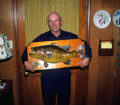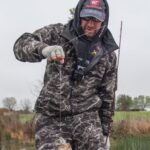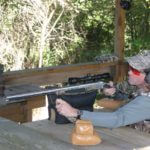Editor’s Note: When anglers find good baits that perform well, catch fish and are readily available, they’ll love that bait. But then a new bait comes on the market that has more flash, a shorter skirt or better cosmetics. The fisherman looks at his old bait. Even though it’s done the job and given him many satisfying hours of fishing, he’s convinced he has to give the new bait on the block a try. When the new bait catches a fish, the old bait is forgotten. This romance lasts for a short period, and then another new bait comes along. The same scene takes place as before. Then years later the angler sees his first, true love on another fisherman’s line. The other outdoorsman is capturing fish, and the first angler begins kicking himself for ever leaving the best bait he ever has known.
Although this story may sound like a fairy tale, it is basically true and indicative of most fishermen. Back when times were hard, and money was scarce, men and boys seined creeks, waded streams and turned over rocks to find fish bait. During the Great Depression of the 1930s and at other times, the crawfish (crayfish) was the favorite bait of most anglers nationwide. Big crawdads were productive bait for catfish, bass, drum and almost anything that swam. The little mudbugs were deadly on bluegills, shellcrackers (redear sunfish) and trout. The bait was easily obtained in almost any creek, stream or mud hole throughout North America. Fishermen in times past caught crawfish by trapping, seining, turning over rocks to hand-catch them or fishing with a piece of bacon tied to a string. These pincered demons could live in a small amount of water in a bucket. They would stay on the hook until taken by a fish. The crawfish was the ultimate bait.
 Then something strange thing happened – fishermen got money. With money in our pockets, wading a branch or a stream for bait lost its glamor. Hardware stores were stocked with flashy, new lures that had pretty-colored skirts, spinners, treble hooks and paint jobs to rival Rembrandt. To keep from being laughed off the lakes, many of us left our first love, the less-than-glamorous crawfish, and bought a box full of artificial lures. The words – artificial lures – even sounded more cosmopolitan than the various names for crayfish – crawdad, mudbug and/or stone crab. And besides, artificial lures were made specifically to catch fish, whereas crawdads were the preferred food of not only various fish, but also frogs, reptiles, birds, minks and raccoons. So, the artificial lures sounded better and looked smarter than the crayfish. We anglers forgot about our old faithful bait and looked to greener pastures.
Then something strange thing happened – fishermen got money. With money in our pockets, wading a branch or a stream for bait lost its glamor. Hardware stores were stocked with flashy, new lures that had pretty-colored skirts, spinners, treble hooks and paint jobs to rival Rembrandt. To keep from being laughed off the lakes, many of us left our first love, the less-than-glamorous crawfish, and bought a box full of artificial lures. The words – artificial lures – even sounded more cosmopolitan than the various names for crayfish – crawdad, mudbug and/or stone crab. And besides, artificial lures were made specifically to catch fish, whereas crawdads were the preferred food of not only various fish, but also frogs, reptiles, birds, minks and raccoons. So, the artificial lures sounded better and looked smarter than the crayfish. We anglers forgot about our old faithful bait and looked to greener pastures.
 But then when Ray Easley caught his famous 21-pound 3-ounce largemouth in 1980 in Lake Casitas, California, that just missed tying the world’s record, the bass-fishing world did a double take. Many folks thought Easley had discovered a new bait when the news media revealed that a crayfish had captured this lunker largemouth. Then old fishing veterans started talking about crayfish and their catching prowess. And, just like the man who sees his old love with a new sweetheart, the bass-fishing world began to rethink the crayfish’s potential.
But then when Ray Easley caught his famous 21-pound 3-ounce largemouth in 1980 in Lake Casitas, California, that just missed tying the world’s record, the bass-fishing world did a double take. Many folks thought Easley had discovered a new bait when the news media revealed that a crayfish had captured this lunker largemouth. Then old fishing veterans started talking about crayfish and their catching prowess. And, just like the man who sees his old love with a new sweetheart, the bass-fishing world began to rethink the crayfish’s potential.
The moguls of the fishing industry figured, “Anglers have dollars in their pockets, and so they’re not going to start wading creeks for bait. We’ll give them a plastic substitute of the crawdad.” Today the marketplace is flooded with phony crawfish. These lures are pretty and they work, but at best they are still only a copy of the real thing. Sometimes progress is two steps back, and this adage is especially true in the world of fishing. The old methods that once caught fish still will work. Many anglers hook live mudbugs through their tails and cast them out without leads. Others hitch the crawdads to hooks by utilizing rubber bands, pipe cleaners or glue.
To learn more about bass fishing, check out John E. Phillips’ eBooks, print books and Audible books at https://johninthewild.com/books#bass. To learn more about fishing for catfish, go to http://amzn.to/W900eu.









